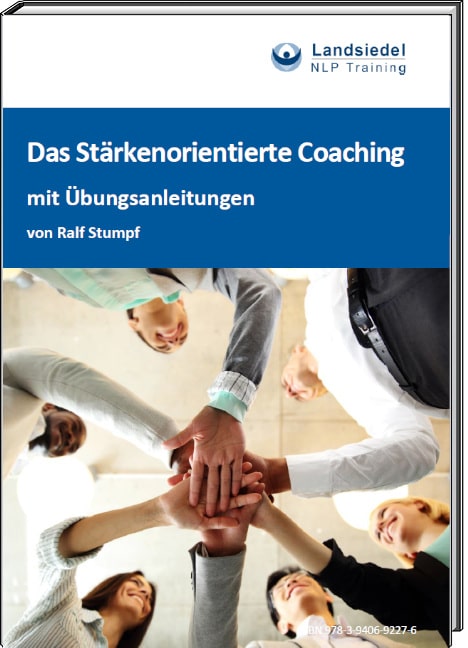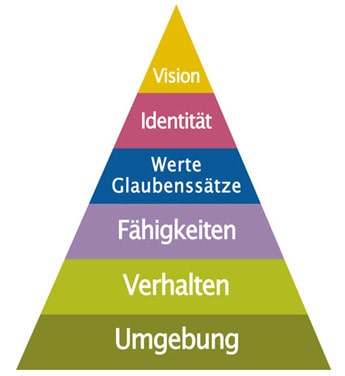Dilts Pyramid – The Neurological Levels
Robert Dilts developed a wonderful model for NLP that can be very useful for our personal development and describing change processes: the Dilts Pyramid.
The model provides valuable inspiration and support for topics such as goals and personality development.
Table of Contents
Free E-Book: Strengths-Oriented Coaching
Contents:
In this e-book, Ralf Stumpf presents the approach of strengths-oriented coaching, which he developed in 2000. The basic idea of this method is to view the coachee as a resourceful person rather than deficient.
In the e-book, Ralf presents six interesting exercises that you can use to apply strengths-oriented coaching with a coachee in the areas of:
Making strengths conscious – Assumptions and expectations – Rapport – Logical levels – Flexibility

What is the Dilts Pyramid?
The model helps to better understand oneself and one’s environment. At the same time, it provides clues as to which level changes need to be made when personal development is to take place. The logical levels are levels of change. They serve to clarify where, for example, a problem, a goal, or one’s mission is situated. The logical levels can be used in problem-solving and resource work.
Through guidance and questions, the resources on each level become conscious and are then integrated into the lower ones. A common misunderstanding of this valuable concept arises from the name “Logical Levels,” since they are neither truly logical (in the philosophical sense) nor strictly separable. For this reason, the term “Dilts Pyramid” is often preferred today.
- Pyramid of Motivation
- Model for structuring change processes
- Higher levels usually influence lower ones more strongly than the reverse
- The solution to a problem is rarely found on the level of the problem itself
- One of my most important coaching models
Robert Dilts
Robert B. Dilts, born in the USA, is an author, trainer, consultant, and developer in the field of Neuro-Linguistic Programming (NLP). He pioneered the application of NLP in organizational development, leadership, and learning. He has worked in over 30 countries with companies such as The World Bank, Isvor Fiat, and IBM Europe.
In the mid-1980s, he created the model of logical levels, adapting it from Gregory Bateson’s logical levels of learning. Since its publication, it has had an immense impact within NLP. It was likely first published in book form in 1990 in “Changing Beliefs with NLP.”
The Levels of the Dilts Pyramid

At the lowest level, the “Environment” (Level 1) is where the person moves with their “Behavior” (Level 2).
Behind behavior lie the “Capabilities” (Level 3) that make it possible to perform any behavior at all.
Behind/above the capabilities is the motivation to want to act or to develop and practice the capability to do so. Because this motivation is not purely instinct-driven, we speak not only of motives but generally of “Values and Beliefs” (Level 4). These constructs (model of the world) serve as criteria for deciding what we believe to be true, right, and important. In NLP, this is often referred to as “beliefs.”
At the 5th level, we define our “Identity” (Level 5). Here we distinguish who we are, what we are, what belongs to us, and what does not.
In the 1990s, Dilts added another level above identity — “Belonging” or “Spirituality.” As NLP evolved, this became part of what he called “Third Generation NLP.” This 6th level is often referred to as “Vision.” Because “Spirituality” can easily be misunderstood, I personally prefer the terms Vision and Belonging for this 6th and, in my view, most important level.
Environment
At the lowest level is the environment. Every event takes place within a specific time and space. The level of environment includes all external conditions that affect a person. They can be experienced through the senses and explored with the questions “Where?”, “When?”, “Who?”, “With whom?”, “Who else?”.
Behavior
The level of behavior refers to all observable actions and reactions of a person: what they do, their words, tone of voice, gestures, movements, breathing. Behavior can be described in sensory-specific terms. This level answers the question “What?”.
Capabilities
Capabilities are cognitive and emotional processes that a person goes through in order to make certain behavior possible. They are not directly observable. This level is about the ability to act, think, and feel, as well as awareness of these capabilities. The key question is “How?”.
Values and Beliefs
The next level is Beliefs — the convictions, values, and inner criteria that underlie a person’s behavior (both consciously and unconsciously). They are the person’s true motives and guiding ideas. People only use their abilities when corresponding beliefs and criteria allow it. Beliefs are interpretations from past experiences — individual theories about why something is the way it is.
Identity
The next level is that of identity: the self-image, the ideas a person has about themselves, their behavior, abilities, and beliefs. Identity – balancing between personal and social identity – can be understood as a belief structure about one’s overall personality.
Vision
The highest level is that of belonging or mission/vision. It concerns our professional, family, social, philosophical, or religious sense of belonging and purpose. This spiritual level guides and shapes our lives and gives our existence a foundation. Here, we deal with the “big questions” in life: “Why do we live?”, “Why are we here?”, “What is the meaning of life?”.
Questions and Examples
| Level | Question | Example |
|---|---|---|
| Environment | Where are you? With whom? What do you hear? What do you see? What do you taste? What do you smell? | The noise in the room makes it difficult to dictate. Anchors can easily be set during a group exercise. “The cancer has affected me.” |
| Behavior | What are you doing here? | You didn’t spell well in this dictation. You set an anchor with this person. “I just can’t behave healthily sometimes.” |
| Capabilities | How do you do what you do? How do you relate to others? What special abilities do you have? | “You can’t spell well.” “You’re capable of anchoring others.” “I’m unable to stay in a good state.” |
| Values and Beliefs | What’s important to you? Why do you do what you do? What do you believe here? What motivates you? What do you believe about yourself, others, your job, etc.? | “If you can’t spell, you’ll never succeed in school.” “Knowing how to anchor makes you an influential person.” “It’s wrong to resist what’s inevitable.” |
| Identity | What is your self-concept? How do you understand yourself, who are you? | “You’re stupid, a learning-disabled child.” “You’re a good NLPer.” “I’m a cancer victim.” |
| Vision | Where do you belong? Professionally, privately, spiritually — is there a group or purpose you belong to? What mission do you have? | “You belong to the learning-disabled.” “You belong to the best of the NLP elite.” “You belong to the victims of cancer who suffer the same fate.” |
The Dilts Pyramid by Example
In relation to stress, we can use the neurological levels by Dilts to identify stressors and activate resources to help us cope with stress. There are many NLP intervention techniques on each level to bring about desired changes.
Environment
- What in your environment causes stress?
- Possible answers: noisy office, conflicts with colleagues, morning meetings, etc.
To reduce stress, it helps to carry out certain tasks in a quieter environment or at a different time of day when the office is calmer. On this level, you identify environmental resources that help prevent stress.
Behavior
- What about my behavior contributes to stress?
- Possible answers: I constantly change my daily routines, attend appointments at the last minute, etc.
After answering, look for helpful behaviors that can serve as resources, such as taking time to relax during lunch breaks or exercising after work. NLP offers many tools for behavioral change. Simply changing one’s physiology (e.g., posture, breathing, voice) can effectively reduce stress.
When dealing with strong stressors, the so-called VK dissociation has proven effective. In this technique, you watch yourself on a movie screen encountering the stressor. By influencing the situation, you can view it calmly and prepare for behavioral change. Classical conditioning methods — in NLP called Anchoring — and Relaxation techniques are also used here.
Capabilities
- How do you perform your tasks? What inner processes or programs run?
- Possible answers: I can’t concentrate. I can’t be on time because something always gets in the way.
To activate resources here, it helps if the client imagines developing the missing skills — for example, arriving on time — and then reflects on what they did to achieve that goal.
On this level, NLP strategies play a special role. These describe the internal processes leading to specific results. The goal is to interrupt ineffective stress strategies and replace them with effective ones modeled after successful examples. In this way, people can quickly develop new skills to deal effectively with stress factors.
Values and Beliefs
- What beliefs might cause stress?
- Possible answers: I must anticipate everyone’s needs. I must always do everything perfectly.
“All beliefs that make you dependent on others’ grace or on external circumstances, or that allow no alternatives, contribute to stress,” write Ian McDermott and Joseph O'Connor in their book “NLP and Health,” which dedicates an entire chapter to stress. They note that beliefs which enhance the sense of control are powerful resources.
Identity
- Who am I when I live these beliefs and capabilities?
- Possible answers: I’m a slave to my schedule. I’m a servant to others.
Healthy self-awareness is a powerful energy source for preventing stress. Self-aware people know who they are and what is good for them. Stress arises when the true self is not expressed — when one hides their personality, suppresses feelings, or wears a mask to protect themselves from others or even from themselves.
It’s important to delve deeper into the true personality. Ask yourself: “Who am I really?” and “What am I like?”. You can also learn through contrast: “Who am I not?” and “How do I not want to be?”. There are NLP techniques for exploring identity. You become aware of your traits (e.g. passionate, patient, vulnerable, etc.) and verify them through reference experiences. Gradually, your self-image becomes clearer.
Vision
- Is there a professional, personal, philosophical, or spiritual group or mission you belong to? What purpose do you serve in this world?
- Answers to these questions contain great resources.
Those who find and live meaningful answers to these questions will no longer perceive stress as such — they’ll feel joy and gratitude for living their true purpose a little more each day.
The boundaries of the current identity can be transcended into a broader sense of self through practices such as meditation, spiritual experience, or love.
Application
-
Part 1: Guiding the desired state through the Neuro-Logical Levels (NL)
- First, conduct a short goal-setting session with A according to the known criteria (positive, self-achievable, contextualized, sensory-specific, ecological).
- Maintain the “as-if frame” throughout the exercise: “Assume you’ve already achieved your goal...” and guide A in that state through all NL levels, starting from Environment and moving upward. Anchor each level with a space anchor, word, or symbol.
If it becomes apparent that resources are missing at a certain level, move up to the next one to find them, then return later to fill the gaps.
Coaching questions on each level:
Environment: Where are you? With whom? What do you hear, see, taste, smell?
Behavior: What are you doing?
Capabilities: How do you do what you do? How do you relate to others? What special abilities do you have?
Beliefs and Values: What is important to you? Why do you do what you do? What do you believe about yourself, others, your work?
Identity: What is your self-concept? Who are you?
Belonging: Where do you belong? Professionally, personally, spiritually? What is your mission?
Take one step further.
Your unconscious will give you an additional important insight here — perhaps an image, symbol, feeling, or idea. It’s a special gift from your unconscious mind for your goal. Take the time to fully absorb it. -
Part 2: Gathering Resources
- Now go back down through the levels, recalling all insights and resources you’ve found. Notice how each level enriches the others.
- If something still feels missing, dissociate and send or anchor new resources, then return to the corresponding level and experience the change.
- Continue to the Environment level and recall your goal. Notice how your goal now feels more complete and powerful.
-
Part 3: Integration and Completion
- Go through all levels again at your own pace, taking the time you need.
- Then make a quick run through all levels from top to bottom without thinking. Return to your starting point and notice how your goal has deepened and become richer.
- Future Pace: When will you take your first steps toward fully realizing your goal?
Continue reading here:

 Deutsch
Deutsch English
English Français
Français 中文
中文 Español
Español नहीं
नहीं Русский
Русский